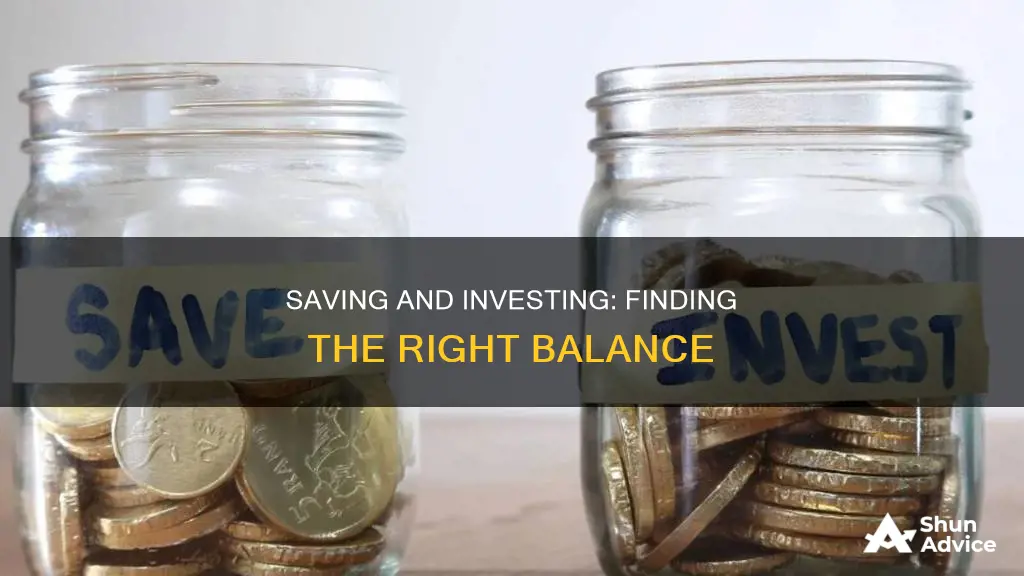
Saving and investing are two different financial activities. While both involve putting away money for future use, they serve distinct purposes and are treated differently. Saving refers to keeping money aside for future financial requirements, typically in safe and liquid accounts such as savings bank accounts, ensuring easy access in case of emergencies. On the other hand, investing involves putting money into financial products, such as stocks, bonds, or mutual funds, with the goal of growing that money over time and creating wealth. Understanding the difference between saving and investing is crucial for effective financial planning, enabling individuals to balance their short-term and long-term goals and build a secure future.
| Characteristics | Values |
|---|---|
| Purpose of saving | Future financial requirement, emergencies, short-term goals |
| Purpose of investing | Wealth creation, meeting future financial goals |
| Risk involved | Low |
| Risk involved | High |
| Returns | Nominal interest |
| Returns | High interest |
| Liquidity | High |
| Liquidity | Low |
| Examples | Cash in hand, money in a savings bank account |
| Examples | Stocks, bonds, gold, real estate, mutual funds |
What You'll Learn

Saving for emergencies
- Determine the amount you need to save: Financial experts generally recommend having three to six months' worth of living expenses set aside. This includes costs such as housing, food, insurance, transportation, debt payments, and personal expenses. This amount can vary depending on your personal situation, such as job stability and the number of dependents.
- Create a budget: Make a budget by listing your monthly income and expenses. This will help you identify areas where you can cut back on spending and determine how much you can realistically save each month.
- Set savings goals: Set a specific dollar amount that you want to save each month. This will help you stay motivated and make saving a habit. For example, you can start with a goal of saving $1,000 as a starter emergency fund.
- Automate your savings: Consider setting up automatic contributions from your paycheck or bank account to your emergency fund. This way, you save effortlessly without having to remember to transfer funds manually.
- Choose the right account for your emergency fund: Keep your emergency fund separate from your checking account to avoid the temptation of spending it. Look for high-yield savings accounts or money market accounts that offer higher interest rates than traditional savings accounts. Ensure you understand the account requirements, fees, and accessibility.
- Prioritize saving over investing: While investing is important for wealth creation, saving for emergencies should take priority. This ensures that you have readily accessible funds to cover unexpected costs without having to resort to high-interest credit card debt or tapping into your retirement savings.
Remember, saving for emergencies is a crucial step towards achieving financial security and peace of mind. It empowers you to handle unforeseen situations without falling into a cycle of debt or compromising your long-term financial goals.
Savings: An Investment Portfolio's Foundation?
You may want to see also

Investing to build wealth
Investing is a crucial aspect of building wealth, and it involves putting your savings into various financial products to grow your money over time. Here are some essential insights on investing to build wealth:
Understanding the Difference Between Saving and Investing
Saving and investing are distinct financial activities that serve different purposes. Saving refers to setting aside a portion of your earnings for future use or emergencies, typically in safe and liquid accounts like savings bank accounts. On the other hand, investing involves purchasing assets such as stocks, bonds, or mutual funds with the expectation of earning returns and creating long-term wealth.
Setting Clear Financial Goals
Before investing, it's important to define your financial goals. Are you saving for retirement, buying a home, funding your child's education, or pursuing an early retirement? Setting clear and specific goals will guide your investment strategy and help you stay focused and motivated.
Diversifying Your Investments
Diversification is a key investing concept. It involves spreading your investments across different types of assets, such as stocks, bonds, real estate, and mutual funds. By diversifying, you can manage risk and protect your portfolio from market downturns because different investments perform well at different times. Mutual funds provide built-in diversification by investing in multiple securities.
Starting Early and Being Consistent
Time is a crucial factor in building wealth through investing. The earlier you start, the more time your investments have to grow and compound. Consistency is also essential—regularly contribute to your investments, even if it's a small amount. Compound interest can turn small sums into fortunes over time.
Managing Risk and Volatility
Investing involves risk, and the value of your investments can fluctuate with market volatility. As a general rule, younger investors can tolerate more risk because they have more time to recover from potential losses. As you approach retirement age, you may want to adjust your portfolio to reduce risk and preserve your wealth.
Seeking Professional Advice
Consider seeking advice from a certified financial planner or advisor, especially if you're new to investing. They can provide guidance on investment strategies, risk management, and portfolio diversification based on your financial goals and risk tolerance. Robo-advisors are also an affordable option, offering managed investment portfolios and access to advisors.
Maximizing Retirement Savings
Take advantage of retirement savings plans such as 401(k)s and individual retirement accounts (IRAs). Contribute enough to get any employer match offered in your 401(k) plan. Additionally, consider tax-advantaged accounts like Roth IRAs, which offer tax-free investment gains.
Protecting Your Assets with Insurance
Insurance is crucial to safeguarding your wealth. Home insurance, auto insurance, and life insurance protect you and your loved ones in the event of unforeseen circumstances. Long-term disability insurance is also valuable, as it replaces your income if you become unable to work due to injury or illness.
Minimizing the Impact of Taxes
Taxes can significantly affect your wealth-building efforts. Understand your tax exposures and seek strategies to minimize them. Invest in tax-advantaged accounts, such as 529 college savings plans, IRAs, and 401(k)s, which offer tax benefits and help reduce your tax bill. Consult a qualified tax professional to develop a tax strategy tailored to your financial situation.
Finding Your Ideal Investment Advisor
You may want to see also

Savings account vs investments
Savings accounts and investments are both important for building a sound financial future, but they serve different purposes and come with their own sets of pros and cons. Here's a detailed comparison of the two:
Savings Account:
- Purpose: Savings accounts are meant for storing money safely and making it readily available for future use. This could include short-term financial goals, such as buying a new gadget or going on vacation, or for emergency funds.
- Risk and Returns: Savings accounts are generally considered low-risk because your money is protected and easily accessible. However, the interest rates are also typically low, which means you may lose purchasing power over time due to inflation.
- Liquidity: Savings accounts offer high liquidity, allowing you to withdraw money as soon as you need it. However, there may be penalties for early withdrawals from certain types of accounts, such as certificates of deposit (CDs).
- Account Types: Examples of savings accounts include traditional savings accounts, money market accounts, and CDs, which are offered by banks or credit unions.
- Ideal for: Savings accounts are ideal for short-term goals and building an emergency fund. It's recommended to have three to six months' worth of living expenses set aside in an emergency fund.
Investments:
- Purpose: Investing is a way to grow your money over time by purchasing financial instruments, such as stocks, bonds, mutual funds, real estate, or gold. The goal is to create wealth and meet long-term financial goals.
- Risk and Returns: Investing involves taking on risk, but it also offers the potential for higher returns compared to savings accounts. There is no guarantee of returns, and you may lose some or all of your investment.
- Time Horizon: Investments are typically meant for the long term, such as saving for retirement, a child's college education, or buying a house. The longer you invest, the more potential you have to ride out short-term market volatility.
- Account Types: Investments are often held in brokerage accounts, which can be opened with independent brokers or brokerage arms of banks.
- Ideal for: Investments are ideal for achieving long-term financial goals. It's recommended to start investing only after you've built up an emergency fund, paid off high-interest debt, and maximized contributions to retirement accounts (e.g., 401(k) or IRA).
In conclusion, both savings accounts and investments play a crucial role in financial planning. Savings accounts provide a safe and liquid option for short-term goals and emergencies, while investments offer the potential for higher returns over the long term but come with inherent risks. Finding the right balance between the two depends on your financial goals, risk tolerance, and time horizon.
Smart Ways to Invest $5,000 Today
You may want to see also

How much to save vs invest
Deciding how much to save versus how much to invest depends on your current needs and future goals. Here are some guidelines and factors to consider when determining how much to save and how much to invest.
Save if you don't have an emergency fund
Financial advisors recommend prioritising saving over investing if you don't have an emergency fund. The general rule of thumb is to save enough to cover at least three to six months' worth of living expenses. This will provide a financial cushion in case of unexpected events, such as job loss or medical bills.
Save if you need the money in the short term
If you anticipate needing access to your money in the near future, it's better to keep it in a savings account rather than investing it. Savings accounts offer more security and immediate access to your funds, whereas investing carries the risk of losing money and often comes with barriers to accessing funds early.
Invest for long-term goals
Investing is generally recommended for long-term goals, such as saving for retirement, building generational wealth, or funding expensive future goals. Compounding returns over time can help your money grow, but it's important to remember that investing also comes with the risk of losing money.
Invest if you have excess cash
If your savings accounts are healthy and your income covers your current expenses, consider investing any extra cash. This will help protect your purchasing power from being eroded by inflation.
Consider your risk tolerance
Saving is generally considered low risk since your money is protected by FDIC insurance in banks or NCUA insurance in credit unions. Investing, on the other hand, carries the risk of losing some or all of your investment. It's important to evaluate your risk tolerance and ensure you are comfortable with the potential volatility of the market before investing.
Start with saving and then invest
It's recommended to build an emergency fund through saving and then consider investing any additional surplus cash. This approach ensures you have financial security and can take advantage of investment opportunities.
In conclusion, the decision on how much to save versus invest depends on your individual circumstances and goals. It's important to assess your short-term and long-term needs, risk tolerance, and financial priorities when determining the appropriate allocation between saving and investing.
Small Investments, Big Retirement: Navigating Early Financial Freedom
You may want to see also

Risk appetite and profile
Risk is an unavoidable part of investing. Whether you invest in stocks, crypto, bonds, or real estate, there is no guarantee of a specific return on your money. Risk means you either make no money, make less money, break even, or get a return on your investment. It's a risk because you're never 100% certain of the outcome.
Risk appetite is the degree of risk an investor is willing to be exposed to in order to achieve a particular financial goal. It is a broad description of the amount of risk an investor is willing to accept to achieve their objectives. It is a statement or series of statements that describe an investor's attitude towards risk-taking.
Types of Risk Appetites
There are three main types of risk appetites:
- Aggressive/High-Risk Appetite: Investors with a high-risk appetite are willing to lose large amounts of money to get potentially huge results. They are often looking for get-rich-quick opportunities or are highly knowledgeable about the market and are unbothered by market conditions.
- Moderate Risk Appetite: Investors with a moderate risk appetite are comfortable with risk but are not willing to lose too much money. They carefully weigh their options and only invest amounts they are willing to lose.
- Conservative/Low-Risk Appetite: Investors with a low-risk appetite are the most conservative and prefer small, steady profits. They build their portfolios with low-volatility instruments that bring gradual returns. These investors are typically older and less wealthy, or new to investing.
Factors Affecting Risk Appetite
Several factors determine an investor's risk appetite, including:
- Income level: Investors with higher incomes and more disposable income can typically afford to take on greater risks.
- Age: Younger investors tend to have a higher risk appetite as they have a longer time horizon to invest and more time to recover from losses. Older investors, especially those closer to retirement, tend to have a lower risk appetite as they need their investments to be more stable and readily available.
- Investment expertise: More experienced investors often have a higher risk appetite as they understand that markets can rise, fall, and recover over time.
- Investment strategy: An investor's strategy and financial objectives also play a role in their risk appetite. For example, someone saving for retirement will have a different risk appetite than someone investing for a holiday or a home deposit.
Risk Appetite and Decision-Making
Understanding your risk appetite is crucial for making well-informed investment decisions. It helps you tailor your investment portfolio and choose appropriate investments. If you take on too much risk, you may panic and sell at the wrong time. On the other hand, if you don't take on enough risk, you may not achieve your financial objectives. Therefore, it is essential to regularly monitor and review your risk appetite and investment portfolio as your circumstances change over time.
Investing in Prancing Horses: A Guide to Buying the Right Ferrari
You may want to see also
Frequently asked questions
Saving is setting money aside in safe, liquid accounts such as savings accounts, whereas investing is buying assets like stocks, bonds, or real estate to earn a return.
Saving money should generally come before investing. It is recommended to have at least 3-6 months' worth of living expenses saved in a highly liquid account before investing.
The best way to build savings is to put money away consistently, even if it is a small amount. Setting up automated small deposits can help, as well as budgeting to ensure expenses are less than your income.
If your employer offers a 401(k) plan, that is a good place to start investing for retirement. Brokerages can help you open a traditional or Roth IRA if you are saving for retirement on your own.







